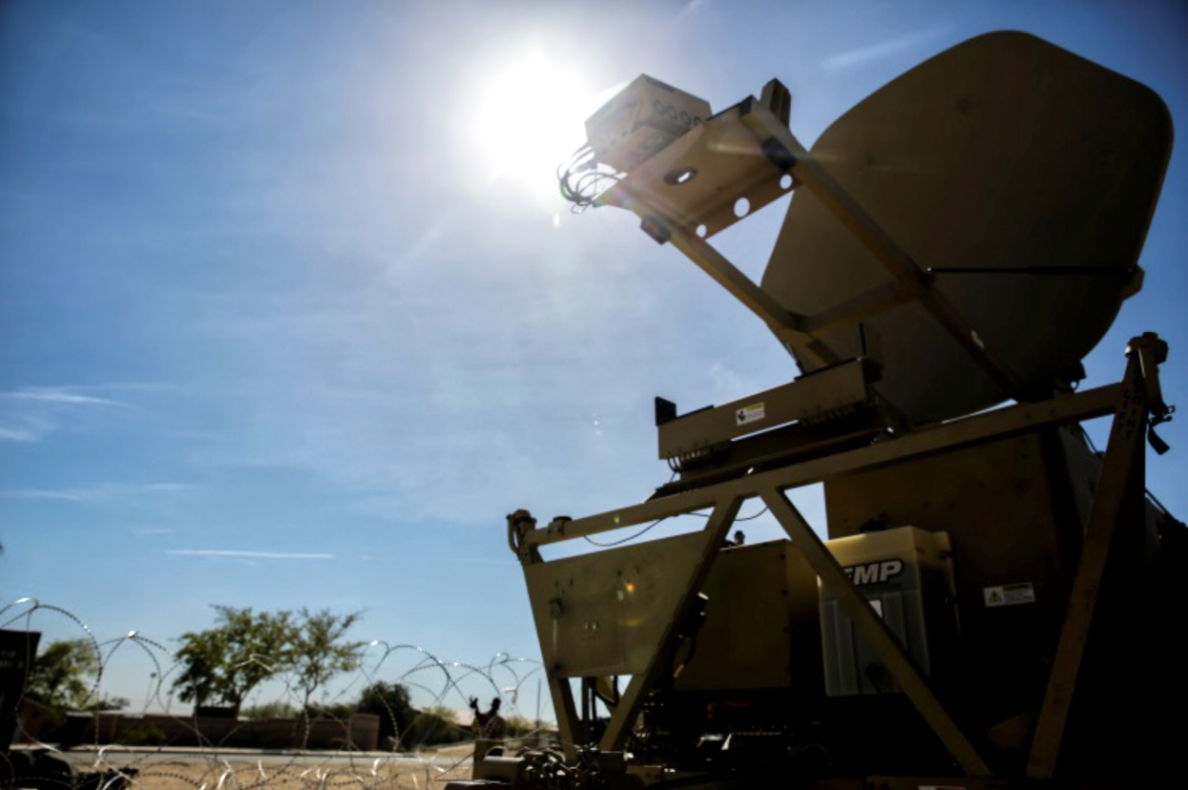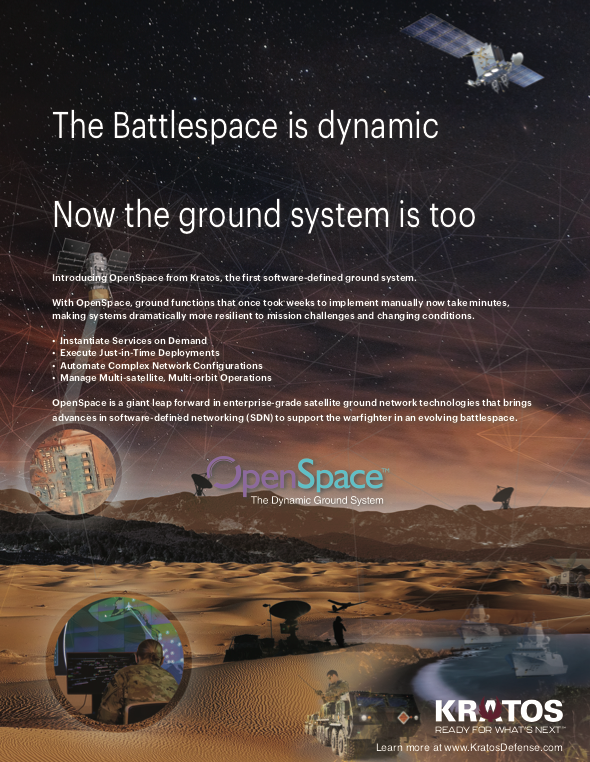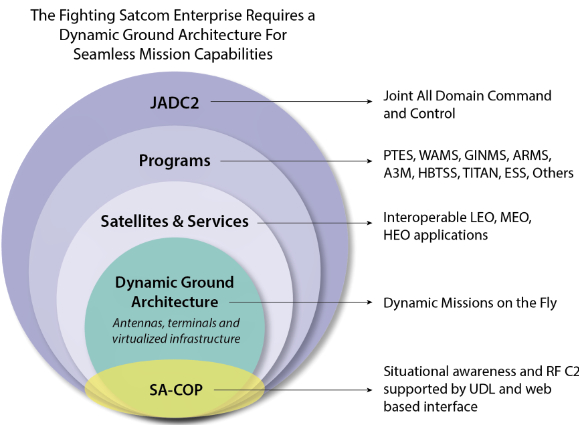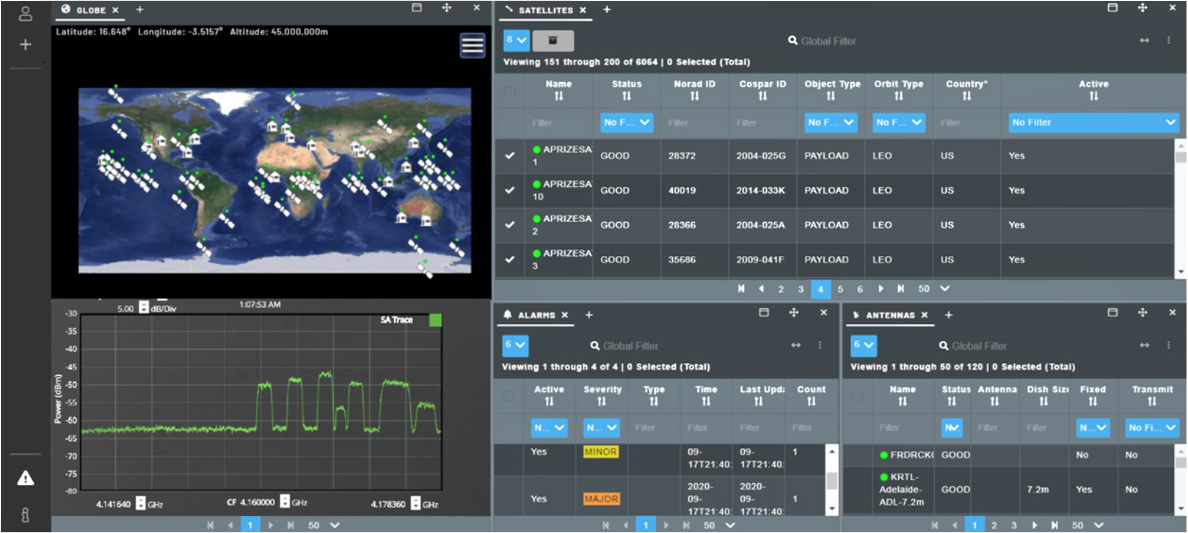
Satellite Transportable Terminals (STT) provide critical infrastructure in the US Army’s Tactical SATCOM network. They are good candidates for integration to the flexible management interface solution.
Operation Desert Storm propelled the Department of Defense (DoD) to realize the value of satellite communications and the indispensability of commercial SATCOM for modern combat. At that time, only 20 percent of all satellite communication services were commercial. By the time of Operation Iraqi Freedom, commercial services accounted for 80 percent of SATCOM.
Unfortunately, despite this growth, multiple organizations independently pursuing their own mission needs produced a multitude of ground based proprietary satellite communication solutions, which in turn created a lack of interoperability between different commercial services and the armed forces.

Those same proprietary solutions remain roadblocks to a dynamic SATCOM infrastructure supporting communication for an evolving military landscape.
Operation Desert Storm propelled the DoD to realize the value of satellite communications and the indispensability of commercial SATCOM for modern combat. At that time, only 20 percent of all satellite communication services were commercial. By the time of Operation Iraqi Freedom, commercial services accounted for 80 percent of SATCOM.
Unfortunately, in spite of this growth, multiple organizations independently pursuing their own mission needs produced a multitude of ground based proprietary satellite communication solutions, which in turn created a lack of interoperability between different commercial services and the armed forces. Those same proprietary solutions remain roadblocks to a dynamic SATCOM infrastructure supporting communication for an evolving military landscape.
Today’s landscape demands a vision where communication between LEO, MEO and GEO is ubiquitous. This requires a move away from proprietary stove-piped systems to flexible, scalable, sustainable and interoperable, and most of all dynamic SATCOM technologies. It has to enable resiliency and expandable SATCOM capacity where it is needed, when it is needed.
This means terminals that can automatically switch between different satellites and warfighters who can seamlessly communicate to networks outside of their domain. If terminals are jammed, there must be a system in place that can automatically locate and help switch to reliable communication links. If redundant terminals or gateways are not available, alternative waveforms must be automatically accessible and applied.
Shifting from closed, proprietary hardware to a virtualized, standards-based software ground infrastructure allows automatic synchronization with digital assets both on the ground and in space. It changes the paradigm by delivering abilities to re-provision hundreds of satellites, thousands of beams, and millions of services in response to changes in demand, interference and threat.
This technology already exists and is operational today in the terrestrial telecommunication world, and that same approach can be applied to SATCOM. For instance, in the terrestrial IP world, communication services are created and moved dynamically upon new service demands at the speed of machine-to-machine API and standards.

There are many advantages to software based systems over proprietary hardware based systems, starting with specialty hardware replaced with commodity infrastructure. It improves speed of deployment and speed to stand-up new services. It allows you to try new things and experiment without long development cycles.
Software allows you to scale fast and fail fast, offering agility, reliability and better security. And notably, it creates a dynamic ability to move services and virtual assets around the network to where they are needed on demand.
A unified virtual ground architecture is a key strategy to making these programs work in the most effective way possible, creating an interoperable environment where communications paths can be deployed dynamically and automatically versus numerous manual configurations with long delays.
The Fighting SATCOM enterprise requires a dynamic architecture using principles of software defined networks and virtualization to unify stovepipe requirements, driven by mission unique circumstances. Such architecture is already being designed.
The United States Space Force (USSF) has defined a vision called the Fighting SATCOM Enterprise that enables interoperable SATCOM technologies. It has several critical elements...
(1) a Command and Control (C2) management system to address and manage the enterprise
(2) a global RF Situational Awareness Common Operational Picture (SA-COP) that allows one to understand any problems being experienced by the enterprise
(3) “wave-form agnostic” multi-mission capable SATCOM terminals that are flexible enough to automatically implement changes throughout the enterprise, with common operating standards driving interoperability across military and commercial SATCOM partners.
Several Enterprise Management and Control (EM&C) efforts have successfully demonstrated synchronized access to multiple satellites and satellite networks operated by multiple service providers. EM&C is the center of a hybrid architecture enabling a more dynamic ground by integrating disparate capabilities.
EM&C shows that the control of multiple modem types and software versions from within a single Terminal, using the digitization of satellite signals to and from the appropriate antenna, is a key technological enabler for Advanced SATCOM management. Connected to a dynamic ground and informed with SA-COP, the system has a comprehensive mission-management ability that can rapidly plan, optimize, apportion, and monitor SATCOM services as well as detect, locate, assess and resolve SATCOM issues for users.

Common standards allow global connectivity for the cellular market.
Unifying Commercial & Military Satellites
Leveraging some of the same advances and investments already in use by commercial industry, the DoD can support interconnectivity without spending additional money on new terminals, hardware or even satellites.
By adopting a common digital ground infrastructure, core capabilities can be connected with a broad span of functions and processes, removing the need for siloed operations. A (predominantly software-based) enterprise architecture can support dynamic
communication path deployment, allowing them to transition from their current network and terminals to alternate communications resources with little or no disruption.
Military and commercial satellite communications systems can tie seamlessly into the terrestrial infrastructure, providing assured and resilient communications on demand while Warfighters are on the move and operating around the globe.
Software Defined Networks Allow SATCOM to Operate Dynamically
Starting with digitizing the RF signal and converting it into a format that is standardized and accepted throughout the industry, commercial and military satellite operations can become interoperable and dynamic. In the same way that infrastructure standards transformed the wireless industry and made it interoperable, the satellite ground must adopt infrastructure standards as well.
Early cell phone networks were not interoperable, a Verizon customer could not send a text to an AT&T user — but a demand for expanded connectivity led to the current, remarkably global cellular infrastructure. Because of the open standards deployed by the telecom industry through their experience in the 90s, you can now use a cell phone in any country.
By agreeing to and following common standards, the satellite industry can also introduce its own interoperability capabilities. Digitizing the RF signal to a common standard such as VITA 49 would evolve ground systems to a digital format, enabling a shift from proprietary, purpose built systems to software-defined, virtual systems. As software-defined network platforms become part of the infrastructure, ground systems will become more dynamic. Digitizing the RF signal and building a common architecture approach for management and control of the satellite network leads to a fundamental shift in the industry. Especially now, with advanced cloud processing speed and capabilities, the same approach that allows software-defined networks to work successfully in the IT and telecom world can be adopted to serve the satellite ground needs in both commercial and military operations.

Global sensors for the RF SA COP will provide data to the United Data Library (UDL) and be leveraged by all commands. Click to enlarge.
Common Standards Enable Seamless Communication
Fighting SATCOM’s Management System supports the planning, directing, monitoring and control of SATCOM. Driven by common standards, it is a tool that will respond to satellite access requests and dynamically allocate SATCOM resources.
As a software-based, standardized digital architecture, it will host and orchestrate virtual network functions and services developed by military or commercial partners. The design avoids vendor lock to any vertically integrated, sole-source solution, while allowing multiple vendors to innovate on compatible waveform-agnostic terminals, Gateways and networks. Rendering the power to quickly instantiate services on demand, it underpins the ability to communicate through multiple ground entry points or government Infrastructure as a Service (IAAS) or Platform as a Service (PAAS).
Automated deployment has been proven to capably spin up a new satellite command and control stack in less than 10 minutes, compared to weeks or longer. Military satellite communications are no longer tied to permanent ground stations, nor are they tied to specific satellites, but instead are limited to network infrastructure decisions such as bandwidth, connectivity, and trust.
Situational Awareness Common Operational Picture (SA-COP)
In the Fighting SATCOM Enterprise, the SA-COP, which is itself based on open standards, gathers all the information from sensors and satellites into one database across stovepipe programs, DoD terminals, user services, frequencies and orbits. Because of that, it will be able to tie into related network resources, with the ability to distribute data to other domains’ C2 systems governed by the same standards in order to execute integrated, multi-domain planning and responses.
The SA-COP, initially developed for the Enterprise Management and Control (EM&C) efforts, reflects a dynamic 3D visualization of the global enterprise, including satellites, beam footprints, and user groups. It can be customized, allowing for the filtering of information by satellite link, terminals/gateways, user groups, terrestrial networks, etc. It gives the health, status and performance of satellite communication links and associated terrestrial networks in real-time, integrates Kratos SATCOM Enterprise Management tools with one view and allows interoperable situational awareness, mission orchestration and ground control capabilities.
Terminal and User Level Flexibility
The Department of Defense (DoD) currently maintains thousands of terminals with approximately 135 different designs. By applying the Flexible Management Interface (FMI) at the monitor and control interface, any of those terminals can be adopted for further use under the Fighting SATCOM Enterprise Vision. The FMI definition allows existing military ground terminals to flexibly use military and commercial SATCOM.
One key potential application is integration with the Protected Tactical Enterprise Service (PTES) when this system becomes available in 2024-2025. The PTES system manages the Government’s next generation Protected Tactical Waveform (PTW) capable networks over WGS and commercial satellites.
The FMI can be extended to support the terminals hosting the Air Force – Army Anti-Jam Modem (A3M) and/or the Wideband Anti-Jam Modem System (WAMS), which are two modems hosting the Government’s next generation Protected Tactical Waveform (PTW). The open standards design allows seamless connection of future terminals between PTES and other SATCOM networks.
This approach supports the underlying objectives of Joint All Domain Command and Control (JADC2) and the Air Force’s Advanced Battle Management System (ABMS).
Fundamentally, the Fighting SATCOM Enterprise ensures a group of capabilities that get the right information to the right people at the right time. Having standards based architecture that is layered and extensible, permits user services to be created on demand and avoids congested spectrum. It gives the ability to fight through jamming issues with dynamic, resilient links and automatically respond to security vulnerabilities. It reduces development risks and helps ensure the government has significantly longer operational life-cycles.

Keys to Fighting SATCOM’s success include maximizing the use of previous U.S. commercial and defense industry sector investments. This has resulted in readily available standards and commercial off-the-shelf (COTS) products to avoid redundant investment in mission-specific software or terminal hardware. These innovative technologies are mature, secure, and can contribute to the wider Multi-Domain Operations (MDO) architecture. ~Velos
Open Architecture Platform Supporting Interoperability
Kratos is in a unique position to support the USSF vision of a fighting SATCOM with common digital ground infrastructure elements supporting military and commercial satellite partners - both on the ground and in space. Warfighters will be able to seamlessly switch between military and commercial SATCOM. Global connectivity will be available even in environments where one or more signals are denied or degraded. The design elements support joint interoperability with commercial partners and the continued utilization of thousands of legacy terminals.
Through the EM&C efforts, Kratos and its partners have successfully demonstrated synchronized access to multiple satellites and satellite networks, operated by multiple service providers. Kratos has helped design the definition for the database that gathers all the information from sensors and satellites used in Fighting SATCOM Enterprise’s SA-COP.
Beyond what is gathered on a program specific basis, the Kratos Global RF Sensor Network gathers commercial SATCOM RF data and populates data with the SA-COP, providing the visualization and management of the space-ground platform from a “single pane of glass.”
SA-COP s the underlying platform for monitoring on Spectral Warrior, GINMS, ARMS, WRMS, TITAN and any number of programs through the same interface. The point being you can integrate all of this data into a single system for a holistic system of systems complete view of the RF spectrum.
Through the EM&C efforts, Kratos and its partners have been actively deploying software solutions that support legacy heterogeneous terminals, allowing them to receive and transport satellite mission data from various satellites and multiple domains. The software works like a translator between the existing proprietary terminal control features and the standards-based FMI. It supports multiple commercial partners’ interoperability with MILSATCOM and ties into the EM&C architecture to support agile, path agnostic connectivity.
Kratos brings the benefits of virtualization to satellite networking, providing the necessary efficiency, agility and resiliency that are fundamental requirements to the Fighting SATCOM Vision. Critical elements such as a management system to address the enterprise, a global RF Situational Awareness Common Operational Picture (SA-COP) that allows one to understand any problems being experienced by the enterprise and wave-form agnostic, multi-mission capabilities are all available for integration into current and future programs.

Chris Badgett is Vice President of Technology for Kratos Space. He has been instrumental in designing the capability for the military to take advantage of virtual ground solutions and the ability to securely leverage the power of cloud computing and global antenna networks. Prior to Kratos, Mr. Badgett served in the Air Force Research Lab and Space and Missile System Center enabling technologies for UAVs, datalinks, small satellites and ground systems. Mr. Badgett holds a BS in Electrical Engineering from University of Tennessee and an MS in Space Systems from the Air Force Institute of Technology.

